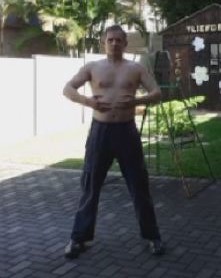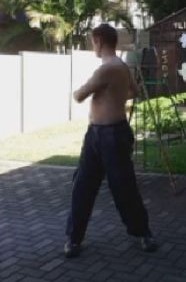Qigong Exercises- Because Abisha asked... :)
I regard Qigong as a really important part of any kind of martial arts training. I know it is not done in all classes. Some MMA gyms have started doing Yoga, which I can understand. Now that we can observe different styles we have the chance to pick from the best of what we see.
The exercises in this post do not take up a lot of time, but are worth starting and ending each training session with.
I have decided long ago not to be a Nei Kung specialist. The main reason for that is that the amount of time and training required for that leaves very little for the external training that I like more. These exercises are therefore the most Qigong I do and just about the most time I spend on cultivating Qi.
I have decided long ago not to be a Nei Kung specialist. The main reason for that is that the amount of time and training required for that leaves very little for the external training that I like more. These exercises are therefore the most Qigong I do and just about the most time I spend on cultivating Qi.
Let's have a look at them:
1. Raising the Sky:
I know two versions of this exercise, but the easiest one starts in a relaxed upright stance. Breathing in the palms turn upward as they get raised up to chest level.
Still breathing in the palms push upward as far as they can go. At this stage the arms and spine should be stretched upward.
Now- as the hands go down to the sides you breathe out. You can now feel the abdomen shrinking and hardening.

Then repeat this at least another 9 times.
2. Dancing Fairy
I don't like the name either...
Stretching the arms as far to the sides as you can lower the one hand as far down as you can while raising the other as high as you can. Then switch.
Stretching the arms as far to the sides as you can lower the one hand as far down as you can while raising the other as high as you can. Then switch.
All this has to be done without bending over backwards or forwards. I have learnt one version of this exercise where both feet remain flat on the ground, but the first version I have learnt- and the one I use involves shifting your weight towards the raised hand's side.
Repeat about 5 times each side.
Repeat about 5 times each side.
2. Water Element Exercise.
While the external movements are quite simple the true value of this exercise lie in the internal aspect thereof.
As the arms raise and you inhale the body is light and soft as qi flows into it and soaks every part.
As the palms descend and you exhale the body becomes heavy and the muscles of the abdomen, chest and limbs harden. It is actually a very subtle introduction to the phases of Fasong and Fajing in exerting force, but this exercise is not to be done with strain. In fact- none of these exercises are...
3. Air Element Exercise
When I got introduced to this exercise and the others by Ashida Kim (Hey! Owen! Stop chuckling! :D) it was done in the Japanese sitting posture in which one sits on one's knees. Well- that is about the only time I saw Qigong being done in a posture like that. The lazy horse stance I use in this exercise keeps the body rooted, but does not divert one's focus to the stance the way a proper horse stance would. In this posture the index fingers and rolled up under the thumbs as the hands rest against the abdomen with palms up. That is the external part. The internal aspect is this:
Breathing in you should feel air racing down the back of your windpipe and lungs. Breathing out air rushes up the front to the outside.
4. Fire Element Exercise (Holding a Ball)
Standing with the arms in this embracing position, or looking as if you are describing Hitomi Tanaka, with your hands open you should get the feeling of holding a large ball. The first method I have learnt was visualising qi running from your left hand to your right and into your lungs as you breathe in and then racing back out through your left arm to repeat the cycle as you breathe out. I don't use it anymore.
Now I just feel the ball contracting as I breathe in and expanding as I exhale. You will feel the ball becoming harder over time.
5. Void Element Exercise
In this exercise the arms circle upward in an arc that is the opposite of what you had in Raising the Sky at #1 above. As the arms leave the body you inhale.
You exhale as the hands complete the circle with the palms facing each other some distance apart. You ought to feel the repelling force between the hands at this stage.
This is repeated about 10 times as well- as with the others.
6. Lohan Embracing Buddha
Now- towards the end of our Qigong session we stand in a natural upright position with the arms in the embracing position (or the Hitomi Tanaka position- if you do not know what I mean... :D)
Then... keeping the feet and legs completely still twist the body to the one side then the other until the body feels warm and loosened up.
7. Conclusion
Many of you have seen this movement, I am sure.
Breathing in raise the hands to your chest with the palms upward. Then-
breathing out, relax and calm down as the palms lower to the front of the abdomen facing down.
8. Meditation
Just because I don't have any photos for this section does not mean that it is not important. In fact- meditation is what recharges you after a heavy training session and replenishes your body's qi reserves. The lotus position is not exclusively the only meditating posture to be used. What is important about meditation, though is the following:
a) Letting go of thought and emotion;
b) Not focussing on anything you see or hear, yet maintaining awareness of all that is going on.
c) Breathing slowly and deeply;
d) Breathing gently- very important;
e) Keeping the back straight;
f) Staying relaxed.
The first 7 exercises can be done before the start of one's training session for the day. At the end all 7 are done again followed by the 8th exercise. It makes a huge difference in one's training.
That's it for today.
'til next time: Train hard and stay well!



















Comments
Post a Comment